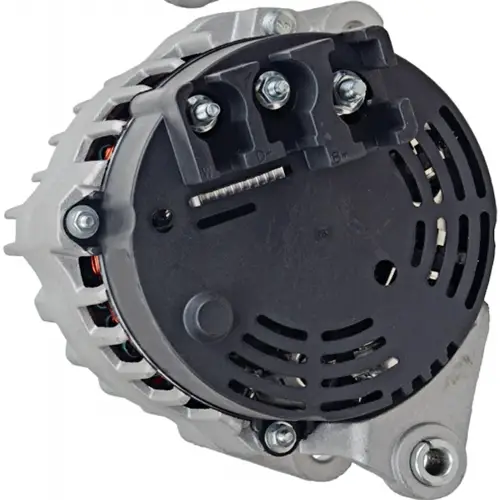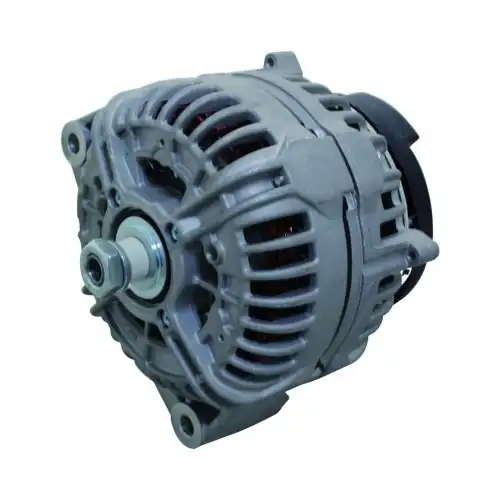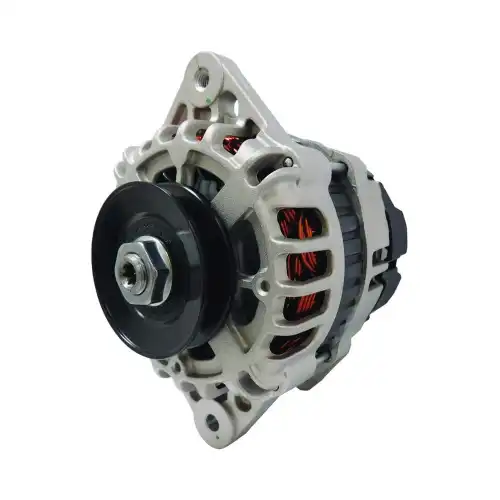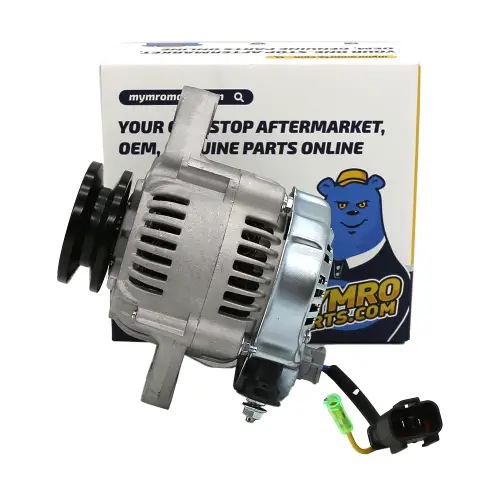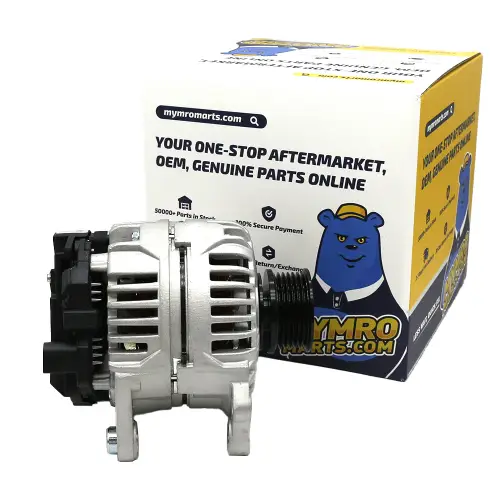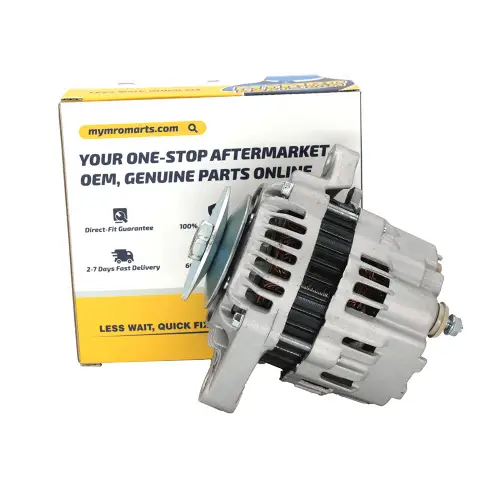Premium Alternator Parts for Efficient Power Generation
Alternator Parts
Alternator parts are like the team players that work together to produce electricity for your construction machinery. Just like a power generator, the alternator converts mechanical energy from the engine into electrical energy. It then supplies this power to the battery and other electrical systems in your construction machinery. So, when you turn on the lights or play the radio, it's the alternator parts that make it possible by generating and delivering the electricity needed. Here are some common alternator parts: Alternator Rotor, Alternator Stator, Brushes and Slip Rings, Alternator Rectifier, Alternator Diodes, Voltage Regulator, and these alternator parts will be described in detail next.
Alternator Rotor
The alternator rotor, the vital parts of alternator, is located at the centre of an alternator. The alternator rotor, which creates the magnetic field necessary to produce electrical power, is a crucial component of the charging system in construction machinerys. We shall go into the specifics of the alternator rotor's design, operation, and importance in assuring effective power generation and what does a rotor do in an alternator in this post.
Usually a cylindrical part, the alternator rotor is built of premium magnetic materials such laminated iron cores or rare-earth magnets. It is fixed to the rotor shaft, which has a pulley system that links it to the engine. High rotational speeds are required for the rotor, which is normally driven by a drive belt attached to the engine's crankshaft.
As the engine rotates, the rotor spins inside the stator, which houses the stator windings. The rotor is energized by a low voltage current supplied through the brushes and slip rings, creating a magnetic field. As the stator windings move along the field lines, the magnetic field causes a current to flow, which produces electricity.
The design and structure of the rotor, among other things, affect the alternator's efficiency and power production. The strength of the magnetic field and overall performance can be affected by elements including the kind of magnetic material used, the rotor's shape, and how the rotor windings are arranged. A well-designed alternator rotor ensures optimal power generation and stable electrical output.
To maintain the efficiency and longevity of the alternator rotor, regular maintenance is essential. Keeping the rotor clean, ensuring the brushes are in good condition, and checking for any signs of wear or damage are important steps. Periodic inspections and servicing can help identify potential issues and prevent costly repairs or breakdowns.
The alternator rotor plays a critical role in the construction machinery's charging system. By generating a magnetic field, it initiates the electrical power generation process within the alternator. This power is then converted to a usable form, rectified to direct current (DC), and supplied to the battery and electrical systems of the construction machinery. The alternator rotor's efficient functioning directly impacts the performance and reliability of the charging system, ensuring a steady power supply for the construction machinery's electrical demands.
Alternator Stator
The alternator in a construction machinery is a key component responsible for generating electrical power. At the core of this power generation system lies the alternator stator. In this article, we will delve into the intricacies of the alternator stator, its construction, function, significance and what is the function of a stator in an alternator in the efficient generation of electrical power.
The alternator stator is a stationary component positioned around the alternator rotor. It consists of a series of wire windings or coils, typically made of copper or aluminum, arranged in a specific pattern. The stator windings are insulated to prevent electrical leakage and are securely mounted within the stator housing.
When the engine is running, the alternator rotor spins inside the stator, creating a rotating magnetic field. This rotating magnetic field induces a current in the stator windings through a process called electromagnetic induction. As the magnetic field lines pass through the stator windings, a voltage is generated, which produces the alternating current (AC) output from the alternator.
The efficiency and power generation capabilities of the alternator depend greatly on the design and quality of the stator. Factors such as the number of windings, their arrangement, and the quality of the insulation contribute to the stator's performance. A well-designed stator ensures optimal electromagnetic induction and efficient power generation.
In order to control the alternator's electrical output, the stator of the alternator is also very important. The construction machinery's voltage regulator regulates the strength of the magnetic field in the rotor to alter the voltage produced in the stator windings. The smooth operation of the electrical system is made possible by this regulation, which guarantees a constant and stable voltage output.
The alternator stator, which supplies the necessary electrical power to charge the battery and supply energy to other electrical components, is an essential part of the construction machinery's electrical system. It ensures a constant and reliable power supply, supporting the construction machinery's electrical demands even at low engine speeds. The stator's efficient operation directly impacts the construction machinery's overall electrical performance and reliability.
Brushes and Slip Rings
In the intricate workings of an alternator, brushes and slip rings play a pivotal role in facilitating the seamless transmission of electrical power. In this article, we will delve into what is the function of slip rings in an alternator, and the construction, starter motor brushes function, and significance of alternator brushes and slip rings, shedding light on their vital contribution to efficient electrical connectivity within the alternator.
Brushes are typically made of carbon or graphite materials due to their excellent conductivity and resistance to wear. They are designed with precise dimensions to ensure proper contact with the slip rings. Slip rings, on the other hand, are typically made of copper or other conductive metals, precisely machined to provide a smooth and continuous surface.
Brushes and slip rings work in tandem to establish an electrical connection between the stationary and rotating components of the alternator. As the rotor spins, the brushes, positioned on opposite sides of the slip rings, exert a controlled amount of pressure against the slip rings' surface. This contact allows for the transfer of electrical current from the stationary stator windings to the rotating rotor windings.
The efficiency and effectiveness of brushes and slip rings are crucial for optimal power generation in the alternator. The brushes' high conductivity and proper contact with the slip rings minimize electrical resistance and ensure efficient transmission of current. By maintaining a consistent electrical connection, brushes and slip rings contribute to the alternator's ability to generate electricity at its maximum potential.
Over time, brushes and slip rings may experience wear due to the mechanical friction during operation. As brushes gradually wear down, their contact with the slip rings may become less effective, leading to reduced electrical transmission and potential performance issues. Regular maintenance and inspection of brushes and slip rings are essential to ensure proper functioning and identify any signs of wear or damage. Timely replacement of worn brushes can prevent electrical inconsistencies and maintain the alternator's performance.
Brushes and slip rings are integral components of the alternator's electrical system, ensuring the continuous flow of electrical power. Their efficient operation directly impacts the performance and reliability of the alternator, ultimately influencing the construction machinery's electrical system. By enabling the transmission of electrical current, brushes and slip rings play a crucial role in supplying power to essential electrical components, including the battery, lights, and other electrical systems.
Alternator Rectifier
In the realm of electrical engineering, alternator rectifiers play a pivotal role in converting alternating current (AC) into direct current (DC). This essential component is widely used in various applications, ranging from power generation systems to automotive industries. We shall delve into the complexities of alternator rectifiers in this essay and how does a rectifier work in an alternator, looking at their operating concepts, uses, and advantages.
Alternator rectifiers' main function is to collect the electrical energy generated by an alternator, which produces AC voltage. The rectifier's primary function is to convert AC electricity into a stable DC current. In the rectification process, diodes are utilised as one-way electric current valves. These diodes effectively change alternating current into direct current by allowing current to flow only in one direction.
Half-wave rectifiers and full-wave rectifiers are the two main varieties of rectifiers frequently utilised in alternators. A single diode is used in half-wave rectifiers to rectify the AC current, producing pulsing DC output. On the other hand, full-wave rectifiers utilize a bridge configuration of diodes, enabling the conversion of both the positive and negative halves of the AC cycle into continuous DC output.
Alternator rectifiers find extensive usage across diverse industries due to their ability to convert AC power to DC power efficiently. Some prominent applications include:
Power Generation: Alternator rectifiers play a vital role in electrical power generation systems, where they convert the AC output of alternators into usable DC power for charging batteries and powering electronic devices.
Industrial Machinery: Alternator rectifier is employed in various industrial machinery, such as welding machines, conveyor systems, and manufacturing equipment. They ensure a steady supply of DC power, enabling consistent operation and control of these machinery.
Alternator Diodes
For alternators to effectively convert alternating current (AC) to direct current, alternator diodes are essential parts (DC). These diodes are crucial for regulating electrical current flow and assuring the dependable performance of various electrical systems. We shall go into the nuances of alternator diodes in this post, including their purpose, varieties, and uses.
The primary function of alternator diodes is to allow the flow of electrical current in only one direction while blocking it in the opposite direction. This rectification process is essential for converting the AC output of an alternator into a stable DC current. By facilitating the unidirectional flow of current, diodes prevent power backflow and ensure a consistent and reliable source of direct current.
Several types of diodes are commonly used in alternators, including:
Silicon Diodes: Silicon diodes are widely employed due to their robustness, efficiency, and ability to handle high current loads. They exhibit low forward voltage drop and excellent temperature stability, making them suitable for demanding applications.
Schottky Diodes: Schottky diodes are known for their fast switching speed and low forward voltage drop. These characteristics make them ideal for high-frequency applications and situations where low power loss is critical.
Zener Diodes: Zener diodes are utilized for voltage regulation purposes. They maintain a constant voltage across a circuit by allowing current to flow in the reverse direction when the voltage exceeds a specific threshold.
Alternator diodes find widespread usage in various industries and applications due to their ability to control current flow. Some notable applications include:
Diodes are crucial components of power generation systems because they guarantee the conversion of AC power produced by alternators into DC power. They make it possible for batteries to be charged effectively and for electrical appliances and devices to receive direct current.
Solar panels and wind turbines are two examples of renewable energy systems that use alternator diodes. They make it easier to transform the AC power produced into useful DC electricity for storage or immediate use.
Voltage Regulator
Because they maintain the output voltage for different electronic systems and devices constant and under control, voltage regulator on alternator are crucial in the field of electrical engineering. These crucial components are widely used in many different applications, ranging from power supplies to automotive systems. In this essay, we will examine the intricacies of voltage regulators and examine their kinds, applications, and significance for reliable power transmission.
The main responsibility of a voltage regulator is to manage and regulate the output voltage of an electrical system or power source. It accomplishes this by checking the input voltage frequently and adjusting it to maintain the output voltage at the proper level. Even when the input voltage varies, voltage regulators make sure that electrical equipment get a constant and stable source of voltage.
There are various types of regulator commonly employed based on their operating principles. Some notable types include:
Linear Voltage Regulators: Linear regulators regulate voltage by dissipating excess energy as heat. They employ a series pass transistor to adjust the output voltage and maintain a constant voltage differential between the input and output. Linear regulators are simple, reliable, and widely used in low-power applications.
Switching Voltage Regulators: Switching voltage regulators, sometimes referred to as DC-DC converters, control voltage by abruptly turning on and off the input voltage. This strategy reduces power loss and boosts effectiveness. Switching regulators are widely used in high-power applications and can handle a variety of input voltages.
Regulators that can be programmed to vary the output voltage within a predefined range are known as programmable regulators. They offer flexibility and adaptation to various system needs, making them suited for applications with dynamic voltage requirements.
Voltage regulators are essential in a variety of sectors and applications because they play a critical role in ensuring a stable power supply. Some prominent applications include:
Electronics and Telecommunications: Voltage regulators are used extensively in electronic devices, such as computers, smartphones, and telecommunication equipment. They ensure that sensitive electronic components receive a consistent and regulated power supply, preventing damage from voltage fluctuations.
 Track Your Order
Track Your Order






